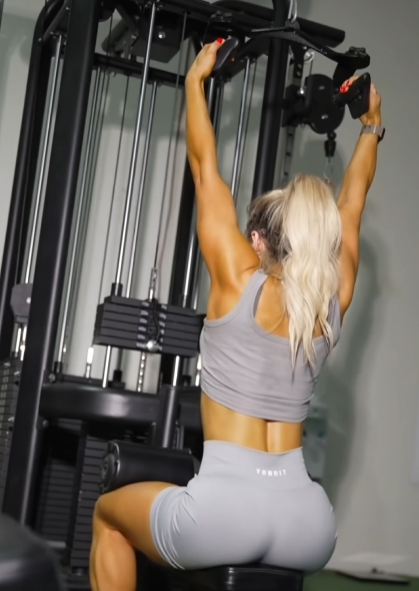
A strong and well-developed back is essential for overall fitness, proper posture, and injury prevention. Whether you’re an athlete, bodybuilder, or fitness enthusiast, incorporating a structured back workout routine can enhance strength, stability, and aesthetics. This article will cover the importance of back training, key muscle groups, effective exercises, common mistakes to avoid, and tips to maximize your back workouts.

The Importance of Training Your Back
The back is one of the largest and most important muscle groups in the body. It plays a crucial role in posture, movement, and upper body strength. Here are some key benefits of back training:
- Improved Posture and Spinal Health
- Strengthening the back muscles helps counteract the effects of prolonged sitting and poor posture, reducing the risk of back pain and spinal issues.
- Enhanced Upper Body Strength
- A strong back improves performance in other exercises, such as bench presses, deadlifts, and overhead presses.
- Better Athletic Performance
- Many sports require strong pulling movements, making back strength essential for activities like rowing, swimming, wrestling, and rock climbing.
- Balanced Muscle Development
- Many gym-goers overtrain their chest and neglect their back, leading to muscle imbalances that can cause postural issues and injuries.

Key Muscle Groups in the Back
Understanding the anatomy of your back will help you target the right muscles during your workouts. The major muscle groups include:
- Latissimus Dorsi (Lats): The largest muscle in the back, responsible for width and the classic V-tapered look.
- Trapezius (Traps): Extends from the neck to the middle of the back and helps with shoulder movement and stability.
- Rhomboids: Located between the shoulder blades, aiding in scapular retraction and posture.
- Erector Spinae: Runs along the spine and supports overall back strength and stability.
- Teres Major and Minor: Assist in shoulder rotation and arm movement.

Effective Back Exercises
A well-structured back workout should include a combination of compound and isolation exercises. Below are some of the best exercises to build a strong and muscular back.
1. Deadlifts
- Targets: Lower back, traps, lats, erector spinae
- How to Perform: Stand with feet hip-width apart, grip the barbell slightly wider than shoulder-width, hinge at the hips, and lift the bar by driving through your heels while keeping a straight back.
- Variations: Conventional deadlifts, sumo deadlifts, Romanian deadlifts
2. Pull-Ups
- Targets: Lats, biceps, upper back
- How to Perform: Hang from a pull-up bar with an overhand grip, pull yourself up until your chin clears the bar, and lower yourself back down in a controlled manner.
- Variations: Wide-grip pull-ups, chin-ups, assisted pull-ups
3. Barbell Rows
- Targets: Lats, traps, rhomboids, lower back
- How to Perform: Hold a barbell with a shoulder-width grip, bend at the hips while keeping your back straight, and pull the bar toward your lower ribcage.
- Variations: Underhand rows, Pendlay rows, T-bar rows
4. Lat Pulldowns
- Targets: Lats, biceps, rear delts
- How to Perform: Sit at a lat pulldown machine, grip the bar wider than shoulder-width, pull the bar down to your chest while keeping your back straight, then slowly release.
- Variations: Close-grip lat pulldown, behind-the-neck lat pulldown
5. Dumbbell Rows
- Targets: Lats, traps, rhomboids
- How to Perform: Place one knee on a bench, hold a dumbbell in the opposite hand, and pull the weight toward your waist while keeping your back straight.
- Variations: Single-arm rows, two-arm rows
6. Face Pulls
- Targets: Rear delts, traps, rhomboids
- How to Perform: Use a rope attachment on a cable machine, pull the rope toward your face while keeping elbows high and squeezing your shoulder blades.
- Benefits: Improves shoulder stability and posture
7. Seated Cable Rows
- Targets: Lats, traps, rhomboids
- How to Perform: Sit at a cable row machine, grip the handle, and pull it toward your torso while keeping your back straight and chest up.
- Variations: Wide-grip rows, close-grip rows
8. Hyperextensions (Back Extensions)
- Targets: Lower back, glutes, hamstrings
- How to Perform: Position yourself on a back extension bench, cross your arms over your chest, lower your upper body, then raise it back up in a controlled motion.
- Benefits: Strengthens the lower back and prevents injury

Common Mistakes to Avoid
Many people make errors that reduce effectiveness or increase the risk of injury. Here are some common mistakes and how to avoid them:
- Using Too Much Weight
- Lifting excessively heavy weights compromises form and increases injury risk. Prioritize proper technique over heavy lifting.
- Relying on Momentum
- Swinging the weight instead of using controlled movements reduces muscle engagement. Slow, deliberate reps yield better results.
- Neglecting Full Range of Motion
- Partial reps limit muscle activation. Ensure each exercise is performed with a full range of motion.
- Ignoring the Lower Back
- Many people focus only on the upper back and neglect lower back exercises, leading to imbalances and a higher risk of injury.
- Not Engaging the Core
- Keeping your core tight during back exercises provides stability and prevents strain on the lower back.

Tips to Maximize Your Back Workouts
To ensure optimal results, follow these strategies:
- Focus on Mind-Muscle Connection
- Concentrate on engaging your back muscles rather than just moving the weight.
- Include Both Vertical and Horizontal Pulling Movements
- Combining pull-ups, lat pulldowns, and rows ensures balanced back development.
- Train with Proper Frequency
- Train your back 1-2 times per week, allowing sufficient recovery between sessions.
- Use Progressive Overload
- Gradually increase the weight, reps, or sets to challenge your muscles and promote growth.
- Ensure Proper Recovery
- Sleep, hydration, and nutrition play crucial roles in muscle recovery and strength gains.
Conclusion
A well-developed back is essential for strength, posture, and athletic performance. Incorporating a variety of exercises that target different muscle groups within the back ensures balanced development and reduces injury risk. By following proper form, avoiding common mistakes, and applying progressive overload, you can build a strong, muscular back that enhances your overall fitness and physique. Whether you’re a beginner or an advanced lifter, prioritizing your back workouts will yield significant long-term benefits.



